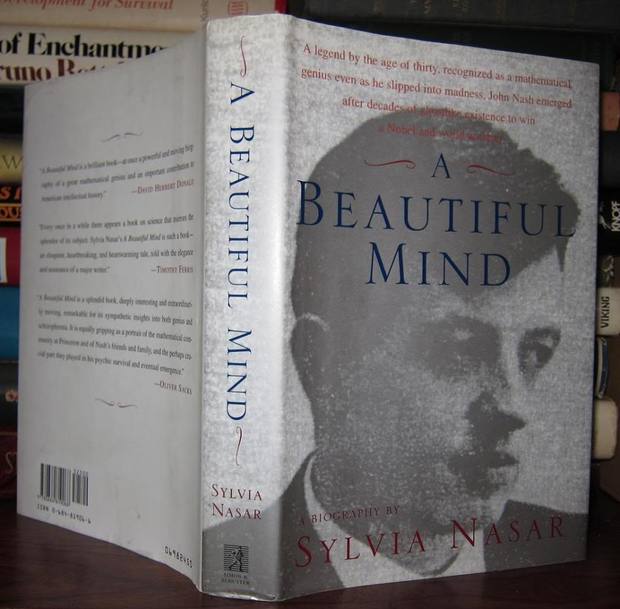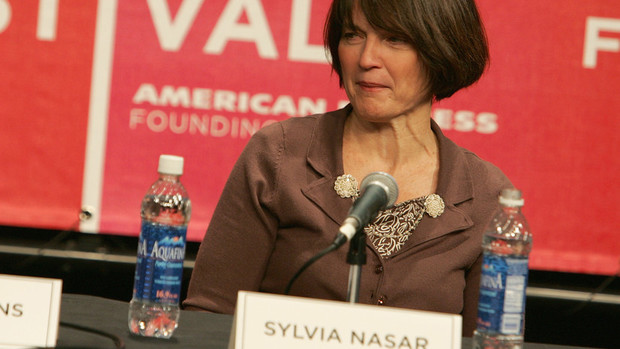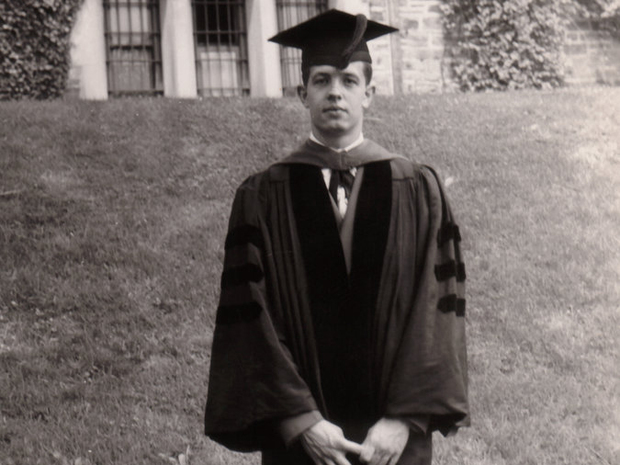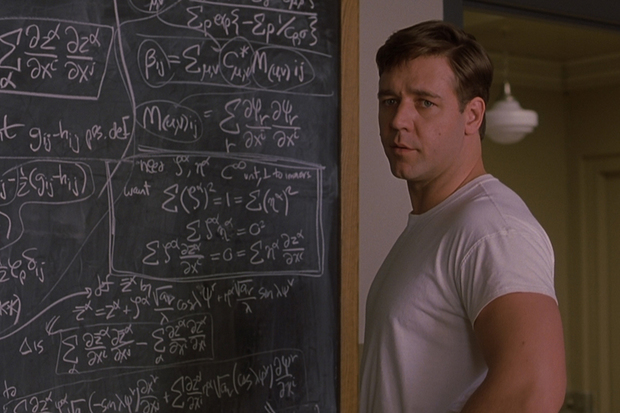John Nash’s Beautiful Mind: Adam Smith's debunking and 30 years of madness
A review of the economic observer of Realnoe Vremya of one of the main intellectual bestsellers of last decades, biography of the genius mathematician
There are books that amaze by the description of how the human mind can rise and fall, and again to revive. The story of John Nash, a brilliant mathematician and Nobel prize winner, described by his biographer Sylvia Nasar, A Beautiful Mind, is so surprising and tragic that it seems to be written by a Hollywood screenwriter. Economic observer of Realnoe Vrmeya online newspaper Albert Bikbov has been waiting for this book here in Russia for a long time, and his expectations have been more than justified — it's truly a masterpiece of documentary biography of one of the greatest minds.
Exemplary book about the genius
It is not surprising that the outstanding Hollywood film with the same name, A Beautiful Mind (2001), directed by Ron Howard with the brilliant acting of Russell Crowe and Jennifer Connelly, was one of the best films in cinema history and won four Oscars. I'm sure many of you have seen the movie — it is one of the most beautiful and touching stories of madness, recovery, discovery, fame, uselessness, loneliness. If you haven't, take the time, I assure you, it's a really incredible film.
In the book, the scientific achievements of Nash and his personal history are described in much more detail than in the movie, besides a reader will find many surprises: life, as always, is much more complicated than a movie. It makes it even more interesting…
The book by Sylvia Nasar A Beautiful Mind. The Life of Mathematical Genius and Nobel Laureate John Nash (A Beautiful Mind was released in the U.S. in 1998, nominated for a Pulitzer Prize, been translated into 30 languages and became an international bestseller. This book is a model of modern scholarly biography and, at the same time, an extremely fascinating reading, it's great, exemplary (and hence very convenient and friendly to a reader) American non-fiction.

Only 18 years after, the book was finally translated into Russian and it was released in October 2016 in the publishing house Corpus within the framework of the AST publishing group of 3,000 copies. The book is quite voluminous — 752 pages. But it is very easy to read. It costs about 710 rubles in the online stores.
Here is some information about the author — Sylvia Nasar, an American economist, writer and journalist. Currently, she is Professor of business journalism at Columbia University. By paternal line she is an Uzbek (by the way, she is very proud of it), by maternal line — a German. From 1977 to 1980, she worked at the Institute of economic analysis, the head of which was the winner of the Nobel Prize in Economics, a native of Russia Vasily Leontiev. From 1991, she worked as an economic correspondent of the New York Times newspaper. In 1999, she left the newspaper, deciding to focus on teaching and writing books. This book was written in the period of her work in the New York Times. According to Sylvia Nasar, she saw Nash in the list of Nobel laureates in Economics in 1994, ran with this story to the chief editor — and the story moved him to tears. For four years of work Sylvia Nasar has studied the biography of Nash so seriously and responsibly, even became very close to the family of Nash:
''It took hundreds of sources to piece together his whole story. No single individual, not even Alicia (the wife of John Nash) or his sons, knew the whole story.
It turned out to be possible to stitch together thousands of bits and pieces — gathered from hundreds of interviews, dozens of letters, and a smattering of documents — into a narrative. It worked partly because the mathematics community is like a Greek chorus — watching, commenting, remembering, filling in the background, explaining the action.
And, of course, it worked because Alicia never stopped believing that something extraordinary is possible. She wanted his story told because she thought it would be inspiring for people with mental illnesses.

A friend once asked Nash where Alicia was. John answered ''Having dinner with Sylvia.'' After a pause, he added, ''I hope they aren't talking about me.''
But for all that Nash himself did not comment for Sylvia. ''Dear Mrs. Nasar, I have decided to take a position of Swiss neutrality...'' he wrote in his typical style.
John Nash advised director Ron Howard and actor Russell Crowe when shooting the film. After Ron Howard showed the film to John and Alicia, Sylvia Nasar called them, ''John, how was it?''. She can't remember his exact words, but remembers that he mentioned three things that he liked: first, it was funny, and second, the action developed rapidly, and John is a fan of action movies. Third, John said: ''I think Russell Crowe looks a little like me.''
Adam Smith is outdated!
Of course, John Nash is known as the Nobel Prize in Economics in 1994 for ''Analysis of equilibria in the theory of non-cooperative games'' (with Reinhard Selten and John Harsanyi). Besides, in 2015, John Nash won the highest award in mathematics — the Abel Prize for contributions to the theory of non-linear differential equations. An Abel in Mathematics and a Nobel in Economics — what is the scale of the genius! Nash was unique: he wrote not many works, and in each case a certain work dramatically changed the understanding of the discipline.
Thus, according to many scientists, he received the Nobel Prize in Economics for just one page of text! We are talking about the famous article Equilibrium Points in N-person games, published in 1950 in the Proceedings of the National Academy of Sciences. This is probably the strongest by brevity, and the highest paid (Nobel Prize!) text in the history of mankind.

In the article, Nash formulated the concept of abstract equilibrium for abstract ''game'', a simple model of strategic interaction — a situation in which the winning party depends not only on what he does himself but also on other participants. For clarity, if to assume that each player makes only one move, you only need to choose your move, the player did not want to reconsider his choice, looking at the choices of other players. Then the set of moves made by the players is the Nash equilibrium. Such equilibrium, as Nash defined it, always exists in any strategic interaction. This is a very important property because the economic model that describes reality should always have some kind of ''equilibrium'' — a state that, according to this model, can be realised in life if the model is adequate.
The Nash equilibrium, formulated in 1950, totally changed the young science — game theory (a mathematical method of studying of optimal strategies in games), which by this time had already been six years old. The mathematical aspects and applications of game theory were first laid out in the classic book of 1944 by John von Neumann and Oskar Morgenstern Theory of Games and Economic Behavior. John Nash at the age of 20, having become acquainted with this book in 1948, immediately saw something in this book that the wide audience could not see at first. He immediately said that it is a weighty book with all mathematical innovation contains no new fundamental theorems, with the exception of an amazing minimax theorem of von Neumann. He came to the conclusion that the new theoretical constructs did not help von Neumann to solve any outstanding task or to substantially develop the theory itself.
For the game theory, the zero-sum games (formulated by von Neumann) are at the same time an extreme case and historically the starting point. In 1949, John Nash, not really straining, found the Nash equilibrium that immortalised him, it fundamentally changed not only the theory of games but also the whole economic science in general. At Princeton, being a student in the master's programme, he boldly asked for an appointment to Professor von Neumann, who at that time was a star of the world level, participating in the American nuclear program and supervising the nascent computer industry. Nash said that he could only tell the Professor a couple of sentences, but von Neumann interrupted him and said sharply: ''It's so trivial. That's just a fixed point theorem.'' The genius von Neumann did not understand another genius, staying literally a step away from the formulation of the famous balance!
In 1950, Nash articulates the solution of a fair ''division of a pie'' (the problem of the division of the transaction result) on eight pages in the article The Bargaining Problem. But the whole economics science was solving this problem for several centuries with no avail! The main idea of this article it is that the result of the transaction depends on what the players would get if the transaction did not take place, and from the potential benefits of the transaction. Such breakthrough forced mathematicians at Princeton University, where Nash studied, to treat the young scientist the most serious way, especially to its ''equilibrium''. He was referred urgently to write a scientific dissertation on this subject (apparently, a one-page article — it was just too fantastically easy). John Nash under duress, reluctantly, with alterations, wrote the thesis Non-cooperative Games in 1951. At 28 pages! This thesis in the form of an article immediately was published in the Annals of Mathematics. After that, the world has become qualitatively different.

The results of John Nash became revolutionary. Adam Smith believed that when each group member acts selfishly, pursuing their own interests, it leads to an efficient equilibrium state of this group. The principle was called the ''invisible hand of the market''. This situation maximises the overall benefit. The economists often call this condition Pareto optimality (Pareto efficiency). At Pareto optimality, the change of the course of action by any player will lead to deterioration of the overall result. However, games, in which each player pursues their own interests, do not lead to Pareto optimality. They lead to the Nash Equilibrium — the situation when it is disadvantageous for any player to change their way of his actions. John Nash showed that when each group member acts only in their own interests, they do not achieve the maximum interests of the group.
In other words, human selfishness ultimately leads not to the most optimal condition, bur rather stable Nash equilibrium, not as optimal from the point of view of society. Adam Smith is outdated!
After all, what did John Nash do for the game theory was appreciated only in the 1980s. Today the game theory is very popular. Often the methods of the game theory are used in economics, less often in other social sciences — sociology, political science, psychology, ethics, law, and others. Since the 1970s it has been adopted by biologists to study animal behaviour and the theory of evolution. It is very important for artificial intelligence and cybernetics, especially with the manifestation of interest in intelligent agents.
There is an excellent documentary film The Trap: What Happened to Our Dream of Freedom, BBC, 2007.
The film is very leftist by the content, but it relatively accurately shows how much the idea of Nash has affected the whole world and formed the basis of a rigid ideology — neo-conservatism, dominant since about the 1980s in the public consciousness of Western Europe, the USA and later in Russia.

32 years of madness
Oddly enough, but in the mathematical world almost everybody thinks that the short article he wrote at the age of 21 and for which he won the Nobel Prize is the least of his achievements. He is called one of the most original mathematical minds of the 20th century. Having written a few pages on the theory of games (mentioned above), he lost interest in this theme and switched to pure mathematics.
In the 1950s, John Nash made a breakthrough in pure mathematics. He formulated and proved the so-called Nash's theorem, linking two different sections of science — algebraic and differential geometry. This result is called the Nash embedding theorem. He used the analysis of arising in a problem differential equations. To him, these systems were considered to be too complex, so he even didn't try to analyze them. The thought of Nash that all diversity can be described by a polynomial equation is incredible — at least because that seems completely implausible that a countless variety of objects could be described in a relatively simple way. This work brought him the Abel Prize in 2015 (math equivalent of the Nobel Prize).
The ease Nash ''hacked'' difficult math problems eventually went to his head, and he at the age of 30 set sights on Holy Grail of pure mathematics — the Riemann hypothesis. The Riemann hypothesis is in the list of seven mathematical 'millennium problems', for each of which the Clay Mathematics Institute, Cambridge, Massachusetts, will pay a reward of one million U.S. dollars. In the case of the publication of the counterexample to the Riemann hypothesis, the scientific council of the Institute of Clay has the right to decide whether to consider this a counterexample final solution to the problem or the problem can be reformulated in a more narrow form and left open (in the latter case, the author of the counterexample may be paid a small part of the reward).
Curiously, as for 2016, only one of the seven millennium problems (the Poincaré conjecture) is solved (Russian Grigory Perelman won the Fields Medal for its solution but he refused to accept it).

The Riemann hypothesis (together with several personal genital problems mentioned in the book) broke Nash. He simultaneously worked on some problems of the quantum field theory, and the load was unbearable. Nash – an eccentric young genius, Einstein's interlocutor and Neumann's background, happy husband and young father, brave bisexual in the era of total homophobia and one of the most promising scientists of his generation – went mad at the age of 30 and delved into the abyss of schizophrenia and paranoia during the next ten years.
The diagnosis – paranoid schizophrenia – was heavy. He wandered and lived by begging, got and decrypted 'messages from extraterrestrials', escaped special services who persecuted him, tried establishing (and chairing) the world government and wandered in the campus of the Princeton University like a ghost. He entered universities barefoot. He had dark shoulder length hair and thick beard, immovable face expression and dead look. It especially frightened women. He often spoke to shadows and began to beat his head against a wall at times.
Sylvia Nasar describes his state in the book the following way:
''His daily rounds extended not farther than the library or the shops at the end of Grandin Road, but in his own mind, he travelled to the remotest reaches of the globe: Cairo, Zebak, Kabul, Bangui, Thebes, Guyana, Mongolia. In these faraway places, he lived in refugee camps, foreign embassies, prisons, bomb shelters. At other times, he felt that he was inhabiting in Inferno, a purgatory, or a polluted heaven (''a decayed rotting house infested by rats and termites and other vermin''). His identities, like the return addresses on his letters, were like the skins of an onion. Underneath each one lurked another: He was C.O.R.P.S.E. (a Palestinian Arab refugee), a great Japanese shogun, C1423, Esau, L'homme d'Or, Chin Hsiang, Job, Jorap Castro, Janos Norses, even, at times, a mouse. He companions were samurai, devils, prophets, Nazis, priests, and judges. Baleful deities – Napoleon, Iblis, Mora, Satan, Platinum Man, Titan, Nahipotleeron, Napoleon Shickelgruber – threatened him. He lived in constant fear of annihilation, both of the world (genocide, Armageddon, the Apocalypse, Final Day of Judgement, Day of Resolution of Singularities) and of himself (death and bankruptcy). Certain dates struck him as ominous, among them May 29.''
Hospitals. Heavy medical treatment (agonising insulin therapy and Thorazine injections), wanders and the state of a 'zombie' – it is all Nash's life during no less than thirty-two years! 32 years of sheer hell for one of the greatest minds of the planet. But the scientific world did not turn its back on him but gave him an opportunity to 'work' at the Princeton University. Students chuckled at him and called him a ghost who wander like a ghost at the university.
An absolute miracle happened then.

Renascence
In 1990, John Nash regained his normal consciousness. He had an amazing remission that took several years. Nash had not only an intellectual but also a spiritual renascence. He became a far better person than he used to be before the illness. To the best of his power, he tried to reconstruct what he damaged or destroyed not a long time ago. He returns the woman he loved, his wife Alicia.
Nobel prize in 1994. The film A Beautiful Mind and worldwide fame. Deserved scientific senility with honourable lectures and new awards for works done 50 years ago. As well as caring for the son who went mad in the same way. Here his mathematical genius affected. Having refused drugs, he managed to formulate his inner law of the fight against schizophrenic thoughts in his head thanks to the remission. He simply checked their rationality and learnt not to pay attention to them. It was tough – he often repeated 'rational thought imposes a limit on a person's concept of his relation to the cosmos'.
Aged 86, John Nash and his spouse Alicia Nash were killed in a car crash in New Jersey on 23 May 2015. The taxi driver lost control while overtaking and struck a guard rail. Both passengers who had unbuckled seat belts were ejected from the car. Doctors verified death on the scene. The taxi driver was sent to the hospital with an injury that did not endanger his life. 'Instant death with your love', so to speak. It is a tale, not life. I sincerely advise you to read this thrilling and grandiose book about a human mind. About John Nash's beautiful mind.